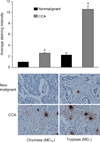Mast cells, disease and gastrointestinal cancer: A comprehensive review of recent findings
- PMID: 22943044
- PMCID: PMC3431027
Mast cells, disease and gastrointestinal cancer: A comprehensive review of recent findings
Abstract
Paul Ehrlich, a German scientist, discovered what is known as the mast cell in the late 1800's, which has proven to be an important player in the immune system of vertebrates. Mast cells are ubiquitous throughout the tissues of the human body and play numerous roles, both beneficial and destructive. We know they are important in our army of immunity warrior cells, which defend us against viruses, bacteria and parasitic invaders. They are also very well known for the havoc they wreak, causing uncomfortable symptoms due to their release of histamine and other mediators which cause the all too familiar itching, sneezing, urticaria and rhinorrhea of allergic responses. Mast cell activities are diverse and include painful inflammatory reactions in autoimmune conditions such as rheumatoid arthritis. In the gastrointestinal system, mast cells are implicated in diverse actions such as increased gastric acid secretion, polyp formation and uncomfortable conditions such as Irritable Bowel Syndrome. The role of immunology and mast cells in these areas is intriguing but less well understood than their role in allergic responses. Because mast cells have been implicated in both physiologic as well as pathogenic processes, they have been the subjects of avid study. Review of the current literature on mast cell biology reveals that there are many studies of their presence within the tumor microenvironment and evidence, which supports mast cell influence on tumor angiogenesis, tumor invasion, and immune suppression. The studies reviewed in this article concentrate largely on mast cells in human GI malignancies. This review also provides background information regarding mast cells, such as their origination, their location within the body, how they are activated and how they function as mediators.
Conflict of interest statement
Figures



Similar articles
-
Mast Cells as Important Regulators in Autoimmunity and Cancer Development.Front Cell Dev Biol. 2021 Oct 12;9:752350. doi: 10.3389/fcell.2021.752350. eCollection 2021. Front Cell Dev Biol. 2021. PMID: 34712668 Free PMC article. Review.
-
Emerging concepts: mast cell involvement in allergic diseases.Transl Res. 2016 Aug;174:98-121. doi: 10.1016/j.trsl.2016.02.011. Epub 2016 Feb 24. Transl Res. 2016. PMID: 26976119 Review.
-
Immunoreactivity for CD25 in gastrointestinal mucosal mast cells is specific for systemic mastocytosis.Am J Surg Pathol. 2007 Nov;31(11):1669-76. doi: 10.1097/PAS.0b013e318078ce7a. Am J Surg Pathol. 2007. PMID: 18059223
-
Beyond IgE: Alternative Mast Cell Activation Across Different Disease States.Int J Mol Sci. 2020 Feb 22;21(4):1498. doi: 10.3390/ijms21041498. Int J Mol Sci. 2020. PMID: 32098318 Free PMC article. Review.
-
Mast cells in gastrointestinal disorders.Eur J Pharmacol. 2016 May 5;778:139-45. doi: 10.1016/j.ejphar.2016.02.018. Epub 2016 Feb 4. Eur J Pharmacol. 2016. PMID: 26852959 Review.
Cited by
-
Vam3, a Compound Derived from Vitis amurensis Rupr., Attenuated Colitis-Related Tumorigenesis by Inhibiting NF-κB Signaling Pathway.Front Pharmacol. 2016 Sep 13;7:311. doi: 10.3389/fphar.2016.00311. eCollection 2016. Front Pharmacol. 2016. PMID: 27679575 Free PMC article.
-
Effect of a Cytoprotective Dose of Dehydroleucodine, Xanthatin, and 3-Benzyloxymethyl-5H-furan-2-one on Gastric Mucosal Lesions Induced by Mast Cell Activation.Int J Mol Sci. 2021 Jun 1;22(11):5983. doi: 10.3390/ijms22115983. Int J Mol Sci. 2021. PMID: 34205991 Free PMC article.
-
Gastrointestinal Manifestations in Systemic Mastocytosis: The Need of a Multidisciplinary Approach.Cancers (Basel). 2021 Jul 1;13(13):3316. doi: 10.3390/cancers13133316. Cancers (Basel). 2021. PMID: 34282774 Free PMC article. Review.
-
Mast Cells and Interleukins.Int J Mol Sci. 2022 Nov 13;23(22):14004. doi: 10.3390/ijms232214004. Int J Mol Sci. 2022. PMID: 36430483 Free PMC article. Review.
-
Mast cell peptidases (carboxypeptidase A and chymase)-mediated hydrolysis of human angiotensin-(1-12) substrate.Biochem Biophys Res Commun. 2019 Oct 22;518(4):651-656. doi: 10.1016/j.bbrc.2019.08.098. Epub 2019 Aug 26. Biochem Biophys Res Commun. 2019. PMID: 31466718 Free PMC article.
References
-
- Silphaduang U, Noga EJ. Peptide antibiotics in mast cells of fish. Nature. 2001;414:268–269. - PubMed
-
- Boyce JA. The biology of the mast cell. Allergy Asthma Proc. 2004;25:27–30. - PubMed
-
- Echtenacher B, Mannel DN, Hultner L. Critical protective role of mast cells in a model of acute septic peritonitis. Nature. 1996;381:75–77. - PubMed
-
- Marshall JS, Jawdat DM. Mast cells in innate immunity. J Allergy Clin Immunol. 2004;114:21–27. - PubMed
-
- Baddeley SM, Bacon AS, McGill JI, et al. Mast cell distribution and neutral protease expression in acute and chronic allergic conjunctivitis. Clin Exp Allergy. 1995;25:41–50. - PubMed
Grants and funding
LinkOut - more resources
Full Text Sources
